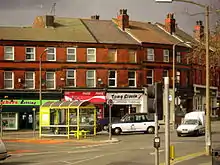Penny Lane, Liverpool
Penny Lane is a street in Liverpool, England. The name also applies to the area surrounding the thoroughfare. The street is off the A562 road. During the 20th century, it was the location for one of the main bus terminals in Liverpool, and gained international renown in 1967 when the Beatles released their song "Penny Lane" in tribute to their upbringing in Liverpool.
 A view down Penny Lane in 2007 | |
| Postal code | L18 |
|---|---|
| Coordinates | 53.3855°N 2.9183°W |
History

Penny Lane was thought to have been named after the 18th-century Liverpool slave trader James Penny.[1] However, the city's International Slavery Museum stated in June 2020 that there is no historical evidence linking Penny Lane to James Penny.[2][3]
The lane appears as an unnamed laneway on maps as early as the 1700s and remained a rural thoroughfare until the 1890s.[4]
After the city's expansion, Penny Lane was the location for a significant tram and bus terminus for several routes, and buses with "Penny Lane" displayed were common throughout Liverpool. The name is also used for the area that surrounds its junction with Smithdown Road, Smithdown Place (where the terminus was located) and Allerton Road, including a busy shopping area. It was the terminus for the number 46 and 99 bus routes to Walton, Old Swan and the city centre. At the other end from its junction on Smithdown Road, the street leads down to the University of Liverpool's student halls of residence near Sefton Park.

The street and bus depot became a place of international interest as a result of the Beatles' song "Penny Lane".[5] Released in February 1967, the song was a number 1 hit on many charts around the world. The fireman and fire engine referred to in the lyrics are the fire station at Mather Avenue, which is close to Penny Lane.[6] The terminus at Penny Lane included a purpose-built bus shelter, with a waiting room and toilets. The shelter is located on its own island, which is "the shelter in the middle of a roundabout" referred to in the song.[7]
Towards the end of the 1970s, businesses in Penny Lane included Penny Lane Records and a wine bar known as Harper's Bizarre, now called Penny Lane Wine Bar. The latter was formerly a doctors' surgery, previously doctors Walton, Endbinder, and Partners; the practice moved to Smithdown Place in the 1980s. Following privatisation, the Merseyside Passenger Transport Executive bus depot was demolished and replaced with a shopping precinct, complete with a supermarket and a pub. In the 1980s, the bus shelter was bought privately and converted to Sgt. Pepper's Bistro. It subsequently closed and remained out of commission until 2015, when it underwent refurbishment with the aim of reopening as a restaurant, although it was still not open as of April 2020.[7][8][9]
The street has long been sought out by Beatles fans touring Liverpool. In the past, street signs reading "Penny Lane" were constant targets of tourist theft and had to be continually replaced. City officials gave up and simply began painting the street name on the sides of buildings and walls. This practice was stopped in 2007, 40 years after the release of the song, and more theft-resistant street signs have since been installed, although some are still stolen.[5] The Penny Lane area has acquired a level of trendiness and desirability in the 21st century. The "alternative" businesses, such as wholefood outlets and charity shops; the array of cafés, bars, bistros, and takeaway food emporiums; and the selection of traditional businesses such as WHSmith make the area the most sought-after among Liverpool's large student population.

Naming controversy
In July 2006, Liverpool city council discussed renaming certain streets because their names were linked to Liverpool's role in the slave trade. On 10 July 2006, officials said they would modify the proposal to exclude Penny Lane as it was generally accepted that most people associate the street with the Beatles' song rather than the slave trade.[10]
In June 2020, during the George Floyd protests in the United Kingdom, which formed part of the international Black Lives Matter movement, Penny Lane's street signs were defaced. The action was attributed to the name's unfounded association with James Penny and was widely condemned.[11][12]
References
- Pandey, Swati (16 July 2006). "Beneath the blue suburban skies". Los Angeles Times. Retrieved 23 February 2011.
- "Penny Lane: Museum finds 'no evidence' of slavery link". BBC News. Retrieved 21 June 2020.
- Jones, Damian (12 June 2020). "Penny Lane road signs in Liverpool have been vandalised following slavery claims". NME.com. Retrieved 14 June 2020.
- Boult, Joseph, ‘Proceedings of the Literary and Philosophical Society of Liverpool.’ Liverpool : Marples, 1876, Vol. 6
- Turner, Steve (2009). A Hard Day's Write: The Stories Behind Every Beatles Song. MJF Books. p. 187. ISBN 1-60671-109-1.
- Miles, Barry. Paul McCartney: Many Years From Now.
- Graves, Steve (5 July 2013). "Liverpool's Beatles-inspired Sergeant Pepper's Bistro to reopen with added second floor". Liverpool Echo. Retrieved 1 October 2016.
- ashwom (1 November 2015). "There Are Places I Remember: Penny Lane: Remastered Promotional film 2015". Beatlesliverpoollocations.blogspot.co.uk. Retrieved 1 October 2016.
- Martin (31 October 2016). "25 BEATLES SITES AND ACTIVITIES IN LIVERPOOL". cityxplora.com. Retrieved 18 January 2017.
- Coslett, Paul (15 February 2007). "Penny Lane". bbc.co.uk. Retrieved 11 May 2018.
- "Penny Lane signs defaced in Liverpool over slavery claims". BBC News. Retrieved 12 June 2020.
- International Slavery Museum [@SlaveryMuseum] (9 June 2020). "There is some debate about whether Penny Lane was named after James Penny ... We are actively carrying out research on this ..." (Tweet). Liverpool. Retrieved 12 June 2020 – via Twitter. |date= mismatches calculated date from |number= by two or more days (help)
| Wikimedia Commons has media related to Penny Lane. |